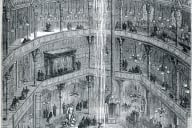You have /5 articles left.
Sign up for a free account or log in.
A doubloon is nailed to the mast of the Pequod. In chapter 99 of Moby Dick, it suddenly rivets Captain Ahab’s attention. He stands on deck staring at the coin, transfixed. And Ishmael, watching him, imagines the captain is trying to interpret it “in some monomaniac way,” weaving it into his own obsessions. It is an effort he can appreciate: “Some certain significance lurks in all things, else all things are little worth, and the round world itself but an empty cipher, to sell by the cartload....”
That quotation serves as an epigraph to Taking Things Seriously: 75 Objects With Unexpected Significance, a collection of photographs and short essays edited by Joshua Glenn and Carol Hayes and recently published by Princeton Architectural Press.
Any number of scholarly volumes and special issues of journals have been devoted to “material culture.” In recent years, there have even been calls for a “thing theory” that would practice (as one manifesto puts it) “a certain ‘methodological fetishism’ that refuses to begin with formal ‘truth’ that cannot, despite its truth, ‘illuminate the concrete, historical circulation of things.’”
Well, you know, I wish everybody a lot of luck with that, but the whole enterprise seems rather lacking in Ishmaelian irony, if not Ahabesque monomania. Fortunately the editors of Taking Things Seriously follow a different course.
“Step into the living room, study, office, studio, or den of just about any engaged, imaginative, passionate individual,” writes Glenn in his introduction, “and you’ll gravitate toward an item that, although it might not appear particularly valuable, is reverently displayed as if it were a precious and irreplaceable artifact.” He and Hayes contacted dozens of artists, writers, and designers and asked them about the “ordinary things instilled with extraordinary significance” they had accumulated. (Like the poet said, “No ideas but in things.”)
The result is a portrait gallery of items – exotic and pedestrian alike – and short accounts of how they came to be charged with meaning for their owners. Turning the pages, you find an electric jig-saw, a decade’s worth of fingernails, a white-clay unicorn’s horn, a torpedo (weighing one hundred pounds), the foam container specially designed to hold a Grammy award....
I posed a few questions about the project to Josh Glenn, who is now in charge of Brainiac, a blog published in connection with the Ideas section of the Boston Globe. A transcript of the e-mail exchange follows.
Q:My left shoe and the coffee table it is beneath are both undoubtedly objects, but neither has much of an aura of meaning or mystery. I value them. They are useful. Their absence would get my attention. But it probably wouldn't be possible to write an essay about either one that would belong in your gallery. So what's the difference between any old object and "things," in your book?
A: I, too, value my left shoe and my coffee table! But I haven't invested them with mental or emotional energy, with complex ideas or strong feelings. Contrariwise, these particular possessions of mine aren't "notional," in the Victorian sense of the term: they don't demand my attention, they don't fascinate me.
It might be tempting to argue that such commonplace items a priori cannot be "objects with unexpected significance," to quote the book's subtitle. But to do so would be a mistake. (After all, Heidegger found Van Gogh's shoes endlessly evocative; and one of the significant objects in Taking Things Seriously is a coffee table of sorts rescued by Ingrid Schorr from a dead neighbor's apartment.)
My interest in someone's extraordinary object -- a grandfather's bayonet, a beloved pet's cremains, a GI Joe whose kung-fu grip still works -- is merely polite. What I find so charming about other people's totems, fetishes, fossils, and talismans is precisely this: Somehow, a perfectly ordinary object has taken on extraordinary significance. How? Why? I never get tired of hearing the answer.
Q: I n the introduction, you cite the French thinker Bruno Latour’s call for "a multifarious inquiry launched with the tools of anthropology, philosophy, metaphysics, history, [and] sociology to detect how many participants are gathered in a thing to make it exist and maintain its existence." But on the whole, this is not a very theoretical book, in any overt way at least. Talk about how that seeming contradiction works out.
A: It's true that Latour is the only philosopher quoted approvingly in my introduction to the book. Unlike ham-fisted "material culture studies" types, whose reductionist interrogation of everyday objects yields exactly what torture will always yield (i.e., nothing but exactly what the torturer expected), Latour's approach to objects is respectful, even humble. He encourages us to enter into dialogue with objects, to allow ourselves to be shocked and amazed by what objects can teach us.
However, the book was never intended to be only a collection of those objects (e.g., Helene Silverman's pharmaceutical-company paperweight, which not only reminds her of a deceased ex-boyfriend but communicates to her his worldview and way of life) that crystallize some aspect of a relationship between individuals. Although Latour is absolutely right to insist that this is what transforms some objects into "things," other things can also be objects of unexpected significance.
So although I'm probably a Latourian insofar as I approach significant objects respectfully, whenever I encounter them in the homes, studios, or offices of friends and acquaintances, I don't assume that I'm going to discover a gathering, network, or association concealed beneath their tarnished surfaces. Some things are fetishes, or totems, or fossils, or "evocative" objects, or something else altogether.
As for how to recognize a thing -- or some other kind of significant object -- when you see one, it's very tricky. Like Melville's Ishamel, who claimed hopefully that "some certain significance lurks in all things," I often feel that objects are attempting to communicate with me, though not in my language. Every significant object speaks a language shared only by its possessor; if I could speak all of those tongues, I would have written Taking Things Seriously by myself. Which would have been easier!
Q:There is quite a literature on collections and collectors, now. You explicitly tried to keep collected objects out of this volume. Why? Do you have something against the collecting impulse?
A: I should point out that my friend Carol Hayes, who designed the book, was also its co-editor. She had reasons of her own for wanting to accept and reject particular submissions; they tended to be aesthetic, as opposed to philosophical reasons. But some of my own editorial decisions were also driven by aesthetics -- by which I mean by a desire to make sure that the reader's experience of the book was X rather than Y or Z.
For example, I didn't want the book to be so full of groovy merchandise that it would resemble a hipster's catalogue. I didn't want it to be crammed with mid-century pop culture memorabilia, although I certainly enjoy looking at such books. And I didn't want to assemble an archive celebrating people's collections of things; there are plenty of those out there already.
That said, I did approach several collectors of my acquaintance, or collectors to whom mutual friends directed me, and asked them if they could single out one of their objects in particular whose significance was extraordinary. I shouldn't have been surprised to discover that the answer, in almost every case, was NO. I shouldn't have been surprised because I collect plenty of things, from early issues of Partisan Review to books with the letter X on its own in the title ("Voyage to Planet X"), and I don't find any one of the items in those collections particularly significant. It's the collection as a whole that's meaningful. Still, a few well-known collectors, including the photographer Rosamond Purcell, the cartoonist Mark Newgarden, and the cultural historian Lynn Peril, did come through.
Q:Apart from your introduction, all of the texts in this book are quite short – usually two or three paragraphs. Some are prose poem-like. Others seem very casual, almost like notes on the other side of a postcard. Do you have any sense of them belonging to a genre? Anything more specific than "creative nonfiction," at least? I still have no idea what that means.
A: As you know, I used to edit and publish Hermenaut, a zine-turned-journal that was "digest-sized" -- meaning it was about the same dimensions as a pulp science-fiction magazine. A couple of years ago, it dawned on me that I could edit books using the same skills I'd honed editing Hermenaut. All I'd have to do (besides selling the project to a publisher) is come up with an appealing theme, draw up a list of writers and artists who'd I'd most like to see tackle that theme, then cajole, nag, and bully them until they'd produced something great. I mention this because I think of Taking Things Seriously as a long-delayed issue of Hermenaut. It just happens to have taken the form of an extra-thick, but digest-sized book.
Thus, rather than describe the 75 contributions to "Things" as chapters, or even essays, I'd use magazine or newspaper terminology. Every one of the texts is a "front-of-the-book" item: short and snappy as a Minor Threat song, easy to enter and even easier to exit. In fact, Taking Things Seriously is a book that's entirely front-of-the-book. Baby's got no back. Many of my favorite books, actually, could also be called front-of-the-book books, from Novalis's "Pollen" to Nietzsche's Daybreak to Feneon's "Novels in Three Lines." (Though, of course, those books are by a single author, and they're not only amusing to read but aphoristic and brilliant; so please note that I'm making a superficial comparison only.)
Some of the texts in Things are fragments -- the kind that can get under your skin. Others, meanwhile, will slip out of your consciousness the moment that you turn the page. If every text in the book were of the former (or the latter) variety, it would be no fun.




